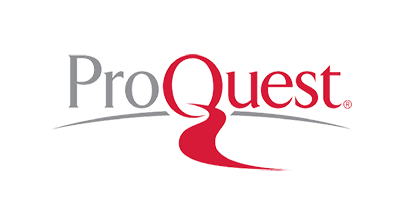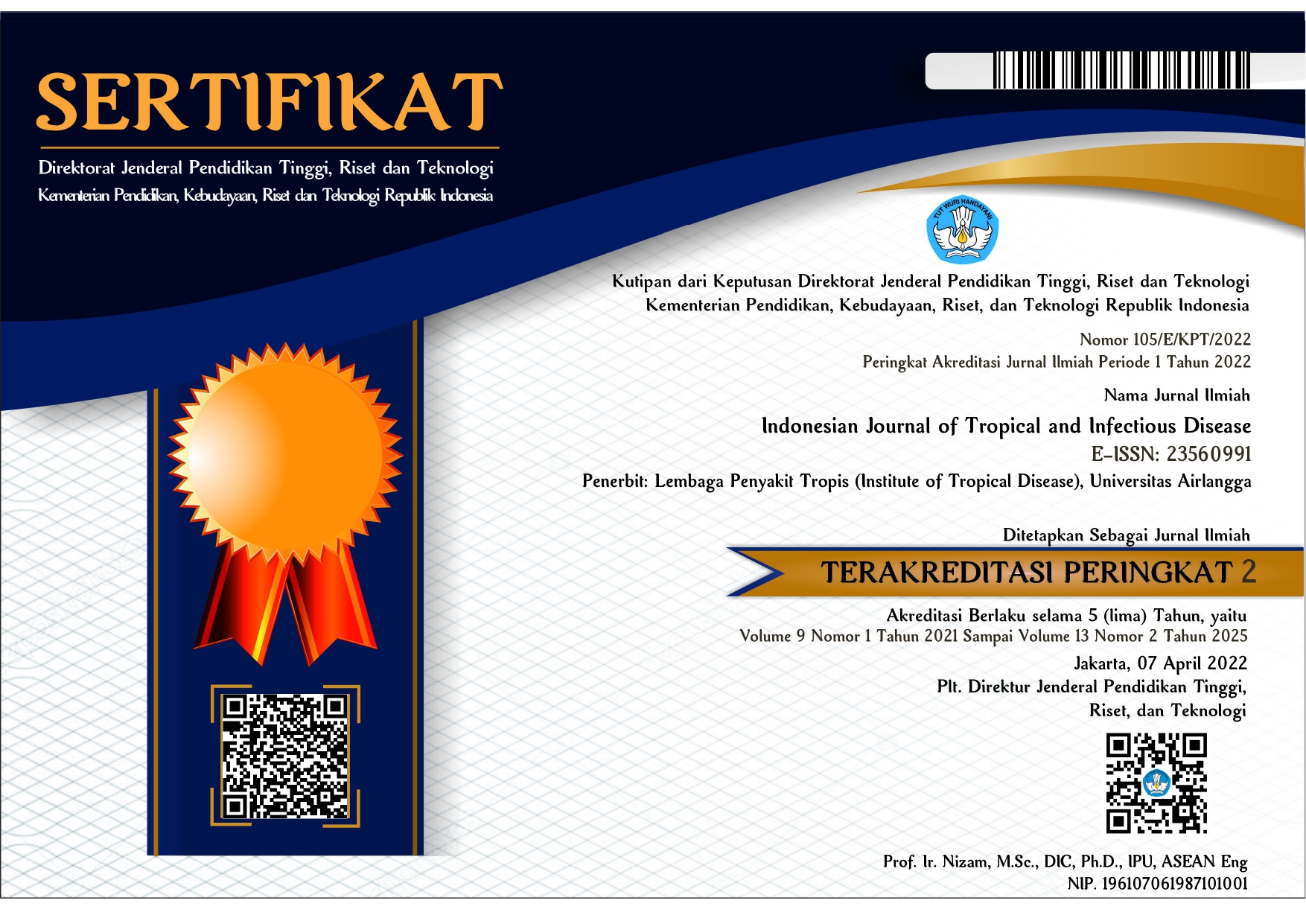Association between Hair Hygiene and Pediculus capitis Infestation among Elementary School Students in Sukorambi District, Jember Regency
Downloads
Pediculus humanus capitis (P.h. capitis) is an ectoparasite which inhabits hair and scalp of human, causing a neglected disease called Pediculus humanus capitis infestation or pediculosis capitis. This disease, easily transmitted between people directly or indirect, often affects girls around 3–12 years old in tropical countries with high humidity. This can be avoided with applying personal hygiene focused on hair area (hair hygiene). Hair hygiene in this study was divided into several parameters, such as frequency of hair washing, shampoo usage, hair drying, towel sharing habit, comb and hair accessories sharing habit, head cover sharing habit, and close contact with an infested person. The aim of this study is not only to know the prevalence of P. h. capitis infestation, but also to determine the correlation between hair hygiene and P. h. capitis infestation among elementary school students in Sukorambi District, Jember Regency. This study was held around January to February 2024 using cross-sectional approach with total 83 respondents. Respondents were given several questions about parameters of hair hygiene and their hair was examined using lice comb to find P. h. capitis. Prevalence of Pediculosis capitis infestation among elementary school students in Sukorambi District reached 71.1%. Statistical analysis showed that towel sharing habit and comb and other hair accessories sharing habit had a significant relationship with P. h. capitis infestation (p-value <0.05). Multivariate analysis using logistic regression showed that comb and other hair accessories sharing habit were the most significant hair hygiene parameters.
Abbas M, Moussa M, Akel H. Type I Hypersensitivity Reaction [Internet]. 2023 [cited 12 August 23]. Available from: https://www.ncbi.nlm.nih.gov/books/NBK560561/
Bharti SN, Umekar MJ, Duragkar NJ. A Review on Pediculus humanus capitis: Based on Life Cycle, Resistance, Safety Considerations and Treatment. Int J Indig Herbs Drugs. 2017;2(2):27–36.
Bragg BN, Wills C. Pediculosis [Internet]. [cited 24 March 23]. Available from: https://www.ncbi.nlm.nih.gov/books /NBK470343/
Cahyarini IGAAC, Swastika IK, Sudarmaja IM. Prevalensi dan gambaran faktor risiko Pediculosis capitis pada anak Sekolah Dasar Negeri 11 Dauh Puri, Provinsi Bali. Jurnal Medika Udayana. 2021;10(10):21–7.
CDC. Head Lice. Available at: https://www.cdc.gov/lice/about/head-lice.html (online). 2024.
Coates S, Thomas C, Chosidow O, Engelman D, Chang A. Ectoparasites: Pediculosis and Tungiasis. J Am Acad Dermatol. 2019;82(3):551–569.
Cummings C, Finlay JC, MacDonald NE. Head Lice Infestations: A Clinical Update. J Paediatr Child Health (Canadian Paediatric Society). 2018;23(1):e18–e32
De Souza AB, De Morais PC, Dorea JPSP, Fonseca ABM, Nakashima FT, Corrêa LL, et al. Pediculosis Knowledge among Schoolchildren Parents and Its Relation with Head Lice Prevalence. Anais Da Academia Brasileira de Ciencias. 2022;94(2):1–15
Fadhillah MF, Anwar C, Liberty IA. Risk Factors for The Event of Pediculosis capitis in The Baturaja Orphanage, South Sumatera, Palembang. Bioscientia Medicina: J Biomed Transl Res. 2021;5(3):843–850.
Firoozfar F, Moosa-Kazemi SH, Bahrami A, Yusuf MA, Saghafipour A, Armoon Z, et al. Head Lice Infestation (Pediculus humanus capitis) Prevalence and Its Associated Factors, among The Kormanj Tribes in North Khorasan Province. Shiraz E Med J. 2019;20(4):1–6.
Gandari HP, Mashuri YA, Sari Y. The association between gender, personal hygiene indicators, and occupancy density with the incidence of pediculosis capitis at Madrasah Tsanawiyah Pondok Pesantren (ponpes) Nurus Sunnah Semarang. Berkala Ilmu Kesehatan Kulit Dan Kelamin. 2024;36(1):53–9.
Kartashova OV, Lobuteva LA, Zakharova OV, Lobuteva AV, Goykhman AA. Medical and Social Factors of Pediculosis. Open Access Maced J Med Sci. 2019;7(19):3240–4.
Kitvatanachai S, Kritsiriwutthinan K, Taylor A, Rhongbutsri P. Head Lice Infestation in Pre-High School Girls, Lak Hok Suburban Area, Pathum Thani Province, in Central Thailand. J Parasitol Res. 2023:1–8.
Kutman A, Parm Ü, Tamm AL, Hüneva B, Jesin D. Estonian Parents’ Awareness of Pediculosis and Its Occurrence in Their Children. Medicina. 2022;58(12): 1–11.
Leung AKC, Lam JM, Leong KF, Barankin B, Hon KL. Paediatrics: How to Manage Pediculosis capitis. Drugs in Context. 2021;11:1–15.
Lukman N, Armiyanti Y, Agustina D. Hubungan Faktor-Faktor Risiko Pediculosis capitis terhadap Kejadiannya pada Santri di Pondok Pesantren Miftahul Ulum Kabupaten Jember. J Agromed Sci. 2018;4(2):102–9.
Maharani A, Pandaleke HEJ, Niode NJ. Hubungan kebersihan kepala dengan pedikulosis kapitis pada komunitas dinding di Pasar Bersehati Manado. E-CliniC. 2020;8(1):163–171.
Maryanti E, Lesmana SD, Novira M. Hubungan Faktor Risiko dengan Infestasi Pediculus humanus capitis pada Anak Panti Asuhan di Kota Pekanbaru. Jurnal Kesehatan Melayu. 2018;1(2):73–80.
Mokhtar AS, Ling LY, Wilson JJ, Abdul-Aziz NM. Genetic Diversity of Pediculus humanus capitis (Phthiraptera: Pediculidae) in Peninsular Malaysia and Molecular Detection of Its Potential Associated Pathogens. J Med Entomol. 2019;20(10):1–12.
Nadira WA, Sulistyaningsih E, Rachmawati DA. Hubungan antara Personal hygiene dan Kepadatan Hunian dengan Kejadian Pedikulosis kapitis di Desa Sukogidri Jember. J Agromed Med Sci. 2020;6(3):161–167.
Nurdiani CU. Faktor-faktor yang mempengaruhi pediculosis capitis pada anak-anak umur 6–12 tahun di Pondok Pesantren Sirojan Mustaqim dan penduduk RW 03 Kelurahan Pondok Ranggon Kecamatan Cipayung, Jakarta Timur. Jurnal Ilmiah Analis Kesehatan. 2020;6(1):39–48.
Rahmawati RK, Teresa A, Mutiasari D, Jelita H, Augustina I. Hubungan tingkat pengetahuan dan perilaku penggunaan sampo terhadap kejadian pedikulosis kapitis di Panti Asuhan X Palangka Raya. Jurnal Kedokteran. 2020;8(1):965–72.
Rumampuk MV. The Importance of Hair and Scalp Hygiene for Pediculus humanus capitis Epidemic Prevention. Jurnal Ners. 2017;9(1):35–42.
Sadhasivamohan A, Karthikeyan K, Palaniappan V. Pediculosis Capitis with Id Reaction and Plica Polonica. Am J Trop Med Hyg. 2021;105(4):862–3.
Sari RP, Handayani D, Prasasty GD, Anwar C, Fatmawati K. Correlation between the use of shared goods with pediculosis capitis among students in Pondok Pesantren Subulussalam Palembang. J Agromed Med Sci. 2020;8(2):78–84.
Sitorus RJ, Anwar C, Novatria. Epidemiology of pediculosis capitis of foster children in orphanages Palembang, Indonesia. Advan Health Sci Res. 2020;25: 202–207.
Suweta NPTB, Swastika IK, Sudarmaja IM. Prevalensi Pediculosis capitis dan Faktor Risiko Infestasinya pada Anak di SD No. 6 Darmasaba, Kecamatan Abiansemal, Kabupaten Badung. Jurnal Medika Udayana. 2021;10(6):54–60.
Torre GLTD, Ponsaran KMG, de Guzman ALDP, Manalo RAM, Arollado EC. Safety, Efficacy, and Physicochemical Characterization of Tinospora crispa Ointment: A Community-Based Formulation against Pediculus humanus capitis. Korean J Parasitol. 2017;55(4):409–16.
Yunida S, Rachmawati K, Musafaah. Faktor-faktor yang berhubungan dengan kejadian pediculosis capitis di SMP Darul Hijrah Putri Martapura: case control study. Dunia Keperawatan. 2016;4(2):124–32.
Copyright (c) 2025 Indonesian Journal of Tropical and Infectious Disease

This work is licensed under a Creative Commons Attribution-NonCommercial-ShareAlike 4.0 International License.
The Indonesian Journal of Tropical and Infectious Disease (IJTID) is a scientific peer-reviewed journal freely available to be accessed, downloaded, and used for research. All articles published in the IJTID are licensed under the Creative Commons Attribution-NonCommercial-ShareAlike 4.0 International License, which is under the following terms:
Attribution ” You must give appropriate credit, link to the license, and indicate if changes were made. You may do so reasonably, but not in any way that suggests the licensor endorses you or your use.
NonCommercial ” You may not use the material for commercial purposes.
ShareAlike ” If you remix, transform, or build upon the material, you must distribute your contributions under the same license as the original.
No additional restrictions ” You may not apply legal terms or technological measures that legally restrict others from doing anything the license permits.























